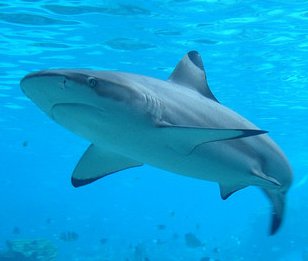Blue Shark
Category: Shark

Facts about Blue Shark, "Scientific name for Blue Shark is Prionace glauca". The Blue Shark species of fish are easy to identify mostly because of their special slim and torpedo shaped figures. The Blue Shark are definitely one of the most beautiful sharks there can be, sadly the Blue Shark is one of the most over fished sharks.
The Blue Shark swimming is extremely stylish, and they are known to be superb swimmers.
Physical description of Blue Shark
The male Blue Sharks average size is between 6.0 to 10 ft (1.82 to 3.04 meters) in length at maturity. The female Blue Shark average length is between 7 feet 2 niches to 11 ft (2.2 – 3.3 meters) when matured. Blue sharks reach up to 13 feet 1 inch (4 meters) in body length, and can weigh The average male weight of blue sharks 60 to 140 lb (27 to 63.5 kg) and females up to 450 pounds (205 kilograms). The dark indigo-colored Blue Shark has a distinct colouration and displays a faded deep blue color on the sides and white on the belly.
Habitat of Blue Shark
Blue Shark is definitely one of the most widely distributed animal or fish in the whole universe. They are migrants and they will love the deep waters of every part of the world except for the one and only Polar Circle. The Blue Shark do thrive in depths of about 1,300 feet (400 meters). They desire an average temperatures of about 50 to 8 degree Fahrenheit (10 to -13 cel).
Social Character of Blue Shark
The Blue Shark species of shark is commonly found in “schools†– these are larger groups of very many individuals. The Blue Shark show a diverse hierarchy and are segregated in size and sex (meaning your can have an entire group comprising of all females or just all men).
Hunting Character of Blue Shark
Blue sharks prefer to feed on squid, though they can also feed on much more than that; this will include smaller sharks, lobsters, Sea birds, bony fish and carrion.
Sensory System of Blue Shark
Just like the other shark species, the Blue Shark has a very special sense of feeling with an organ known as ampullae of Lorenzini. This enables the Blue Shark species to track its prey using electromagnetic pulse that every living creature emits; amazingly they can sense your heart beat from very far away.
The most common predators of blue sharks are great white sharks, tiger sharks, killer whales and of course humans.
The Blue Shark are considered to be a non aggressive to the humans. There are very few reported Blue shark attack cases; they will only attack when they feel threatened. They are the most fished sharks, making humans the number one natural enemy of Blue shark.
The average lifespan of blue shark is 20 years. There are over 400 types of sharks, Sharks have the most powerful jaws on on earth. Blue Sharks jaws, both the upper and lower jaws move. Blue Sharks skin is made of denticles instead of scales like other fish. The denticles are constructed like hard, sharp teeth (tooth-like projection) and this helps to protect the Blue Shark from being injury. The Blue Shark is carnivores meaning: an animal that feeds on flesh (Meat).
Blue sharks viviparous: Meaning- birthing live young that developed inside the body of the female, in this case Blue shark. Females do not give birth until they are about 2 years of age after mating. The Blue shark gives birth of pups between 25 to 100 after going through a gestation period of 9 to 12 months. Blue shark pups reach maturity at the age of 5 to 6 years.

 Back To Category Shark
Back To Category Shark